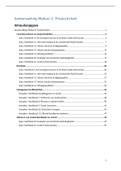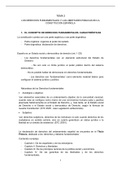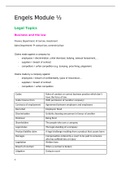Branding for Start-Ups – Articles
Week 1
Keller, K. L., & Lehmann, D. R. (2003). How do brands create value? Marketing Management,
12(3), 26-31. [5 pp.]
The brand value chain offers a holistic, integrated approach to understanding the value
created by brands. According to the model, brand value creation begins with the firm’s
marketing activity. This influences customers, who, in turn, affect how the brand performs in
the marketplace and is ultimately valued by the financial community.
Market Program Investment -> Customer Mindset -> Brand Performance -> Shareholder
Value
Market Program Investment
Any marketing program investment that potentially can affect brand value development,
either intentionally or not, falls into this category. Examples: product research, development
and design; trade or intermediary support; marketing communication; and employee
selection, training, and support.
Assessment: marketing plan and budget.
Customer Mindset
The customer mindset includes everything that exists in the minds of customers with respect
to a brand (e.g. thoughts, feelings, experiences, images, perceptions, beliefs, and attitudes).
Key dimensions as important measures:
- Brand awareness and the extent to which customers recall and recognize the brand
and can recall the products/services associated with it.
- Brand associations, which include strength, favorability, and uniqueness of perceived
attributes and benefits for the brand. (often key sources of brand value -> means by
which consumers feel brands satisfy their needs).
- Brand attitudes and overall evaluations of the brand in terms of its quality and the
satisfaction it generates.
- Brand attachment, or how loyal the customer feels toward the brand.
- Brand activity, the extent to which customers use the brand, talk to others about it,
and seek out information, promotions, and events.
Hierarchy in dimensions: Brand value is created when customers have a high level of
awareness, SFU brand associations, positive brand attitudes, intense brand attachment
and loyalty, and a high degree of brand activity.
Assessment: customer surveys
Brand Performance
How customers react or respond in the marketplace to the brand.
Key dimensions/aspects of that response:
- Price premiums: how much extra are customers willing to pay for a comparable
product because of its brand?
- Price elasticities: how much does customers’ demand for the brand increase/decrease
when the price falls/rises?
- Market share: the success of the marketing program in driving brand unit sales.
, - Expansion success: success of the brand in supporting line and category extensions
and new product launches into related categories.
- Cost structure: the ability to reduce marketing program expenditures for the brand
because of the prevailing customer mindset.
- Profitability
First three dimensions determine the direct revenue stream attributable to the brand
over time.
The first five dimensions lead to brand profitability.
Assessment: market scans and internal accounting records
Shareholder value
Based on availability about a brand, as well as many other considerations, the financial
marketplace formulates opinions and makes various assessments that have direct financial
implications for brand value.
Thee important indicators:
- Stock price
- P/E multiple
- Market capitalization
What it Takes
- Value creation begins with marketing program investment: well-funded, designed,
and implemented marketing program.
- Recognizing uncontrollable nature of external factors that potentially inhibit value
creation. The farther to the right along the BVC, the less control. So, it’s critical to
generate momentum with the marketing program at the beginning of the BVC so
value will carry through the rest of the chain.
- In some cases, value creation may not occur sequentially.
- Some marketing activities may have effects that are only manifested over the long
term.
Keller, K. L. (2016). Reflections on customer-based brand equity: perspectives, progress, and
priorities. AMS review, 6(1-2), 1-16. [14 pp.]
Key Topics CBBE
Functions brands:
- Reduce risk
- Set expectations
- Create tangible and intangible value
Customer-based brand equity: The differential effect that brand knowledge has on customer
response to brand marketing activity.
3 Dimensions:
- Differential effects created by a brand.
- Brand knowledge (any type of mental brand associations) as the source of the
differential effects.
- Response to a wide variety of different marketing and other variables for the brand as
the basis or outcomes of those differential effects.
,Building CBBE:
- Choosing brand identities or elements.
- Designing and implementing marketing activities themselves.
- Leveraging secondary associations by linking the brand to another entity (person,
place or thing).
Measuring CBBE:
- Indirect approach: measuring brand knowledge.
- Direct approach: measuring the differential effect created by that brand knowledge on
consumer response to different aspects of the brand’s marketing program.
Guidelines for managing CBBE:
- Emphasizing the importance of taking a broad and long-term view of marketing a
brand.
- Specifying the desired consumer knowledge structures and core benefits for a brand.
- Considering a wide range of traditional and nontraditional advertising, promotion, and
other marketing options.
- Coordinating the marketing options that were chosen.
- Conducting tracking studies and controlled experiments.
- Evaluating potential extension candidates.
Brand Knowledge:
- Brand awareness: brand recall and recognition.
- Brand image: strength, favorability and uniqueness of different kinds of attribute and
benefit associations for the brand.
Awareness, attributes, benefits, images, thoughts, feelings, attitudes, and experiences.
Marketing activity creates or affects multiple dimensions of brand knowledge.
Multiple dimensions of brand knowledge, in turn, influence consumer response to
marketing activity.
Brand resonance model (the extent to which a consumer feels he or she is “in synch” with a
brand).
The model focuses on key dimensions of brand knowledge and how they affect resulting
consumer brand relationships.
- Salience (base level): breadth and depth of brand awareness, depends on the extent to
which the brand is thought of easily and often – at the right times, in all the right
places, and in all the right ways.
- Performance and Imagery (level 2): duality of brands in terms of tangible and
intangible associations.
- Judgements and Feelings (level 3): duality of brands in terms of rational and
emotional responses.
Left-hand side: rational route
Right-hand side: emotional route
Cross-over effects
PoD + PoP as basis of positioning.
4 components:
- Behavioral loyalty: repeat buying.
- Attitudinal attachment: creating strong bonds with the brand.
- Sense of community: creating strong bonds with each other and the company as a
whole.
, - Active engagement: when consumers are willing to invest time, energy, money, and
other personal resources in the brand beyond those expended during purchase or
consumption of the brand.
Brand value chain model
See article: Keller, K. L., & Lehmann, D. R. (2003). How do brands create value? Marketing
Management, 12(3), 26-31. [5 pp.]
Week 1
Keller, K. L., & Lehmann, D. R. (2003). How do brands create value? Marketing Management,
12(3), 26-31. [5 pp.]
The brand value chain offers a holistic, integrated approach to understanding the value
created by brands. According to the model, brand value creation begins with the firm’s
marketing activity. This influences customers, who, in turn, affect how the brand performs in
the marketplace and is ultimately valued by the financial community.
Market Program Investment -> Customer Mindset -> Brand Performance -> Shareholder
Value
Market Program Investment
Any marketing program investment that potentially can affect brand value development,
either intentionally or not, falls into this category. Examples: product research, development
and design; trade or intermediary support; marketing communication; and employee
selection, training, and support.
Assessment: marketing plan and budget.
Customer Mindset
The customer mindset includes everything that exists in the minds of customers with respect
to a brand (e.g. thoughts, feelings, experiences, images, perceptions, beliefs, and attitudes).
Key dimensions as important measures:
- Brand awareness and the extent to which customers recall and recognize the brand
and can recall the products/services associated with it.
- Brand associations, which include strength, favorability, and uniqueness of perceived
attributes and benefits for the brand. (often key sources of brand value -> means by
which consumers feel brands satisfy their needs).
- Brand attitudes and overall evaluations of the brand in terms of its quality and the
satisfaction it generates.
- Brand attachment, or how loyal the customer feels toward the brand.
- Brand activity, the extent to which customers use the brand, talk to others about it,
and seek out information, promotions, and events.
Hierarchy in dimensions: Brand value is created when customers have a high level of
awareness, SFU brand associations, positive brand attitudes, intense brand attachment
and loyalty, and a high degree of brand activity.
Assessment: customer surveys
Brand Performance
How customers react or respond in the marketplace to the brand.
Key dimensions/aspects of that response:
- Price premiums: how much extra are customers willing to pay for a comparable
product because of its brand?
- Price elasticities: how much does customers’ demand for the brand increase/decrease
when the price falls/rises?
- Market share: the success of the marketing program in driving brand unit sales.
, - Expansion success: success of the brand in supporting line and category extensions
and new product launches into related categories.
- Cost structure: the ability to reduce marketing program expenditures for the brand
because of the prevailing customer mindset.
- Profitability
First three dimensions determine the direct revenue stream attributable to the brand
over time.
The first five dimensions lead to brand profitability.
Assessment: market scans and internal accounting records
Shareholder value
Based on availability about a brand, as well as many other considerations, the financial
marketplace formulates opinions and makes various assessments that have direct financial
implications for brand value.
Thee important indicators:
- Stock price
- P/E multiple
- Market capitalization
What it Takes
- Value creation begins with marketing program investment: well-funded, designed,
and implemented marketing program.
- Recognizing uncontrollable nature of external factors that potentially inhibit value
creation. The farther to the right along the BVC, the less control. So, it’s critical to
generate momentum with the marketing program at the beginning of the BVC so
value will carry through the rest of the chain.
- In some cases, value creation may not occur sequentially.
- Some marketing activities may have effects that are only manifested over the long
term.
Keller, K. L. (2016). Reflections on customer-based brand equity: perspectives, progress, and
priorities. AMS review, 6(1-2), 1-16. [14 pp.]
Key Topics CBBE
Functions brands:
- Reduce risk
- Set expectations
- Create tangible and intangible value
Customer-based brand equity: The differential effect that brand knowledge has on customer
response to brand marketing activity.
3 Dimensions:
- Differential effects created by a brand.
- Brand knowledge (any type of mental brand associations) as the source of the
differential effects.
- Response to a wide variety of different marketing and other variables for the brand as
the basis or outcomes of those differential effects.
,Building CBBE:
- Choosing brand identities or elements.
- Designing and implementing marketing activities themselves.
- Leveraging secondary associations by linking the brand to another entity (person,
place or thing).
Measuring CBBE:
- Indirect approach: measuring brand knowledge.
- Direct approach: measuring the differential effect created by that brand knowledge on
consumer response to different aspects of the brand’s marketing program.
Guidelines for managing CBBE:
- Emphasizing the importance of taking a broad and long-term view of marketing a
brand.
- Specifying the desired consumer knowledge structures and core benefits for a brand.
- Considering a wide range of traditional and nontraditional advertising, promotion, and
other marketing options.
- Coordinating the marketing options that were chosen.
- Conducting tracking studies and controlled experiments.
- Evaluating potential extension candidates.
Brand Knowledge:
- Brand awareness: brand recall and recognition.
- Brand image: strength, favorability and uniqueness of different kinds of attribute and
benefit associations for the brand.
Awareness, attributes, benefits, images, thoughts, feelings, attitudes, and experiences.
Marketing activity creates or affects multiple dimensions of brand knowledge.
Multiple dimensions of brand knowledge, in turn, influence consumer response to
marketing activity.
Brand resonance model (the extent to which a consumer feels he or she is “in synch” with a
brand).
The model focuses on key dimensions of brand knowledge and how they affect resulting
consumer brand relationships.
- Salience (base level): breadth and depth of brand awareness, depends on the extent to
which the brand is thought of easily and often – at the right times, in all the right
places, and in all the right ways.
- Performance and Imagery (level 2): duality of brands in terms of tangible and
intangible associations.
- Judgements and Feelings (level 3): duality of brands in terms of rational and
emotional responses.
Left-hand side: rational route
Right-hand side: emotional route
Cross-over effects
PoD + PoP as basis of positioning.
4 components:
- Behavioral loyalty: repeat buying.
- Attitudinal attachment: creating strong bonds with the brand.
- Sense of community: creating strong bonds with each other and the company as a
whole.
, - Active engagement: when consumers are willing to invest time, energy, money, and
other personal resources in the brand beyond those expended during purchase or
consumption of the brand.
Brand value chain model
See article: Keller, K. L., & Lehmann, D. R. (2003). How do brands create value? Marketing
Management, 12(3), 26-31. [5 pp.]











